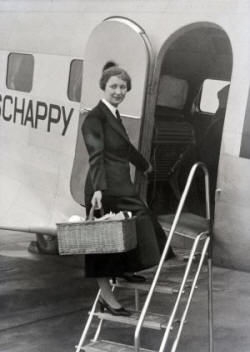

Partner Sonja Bonhoffer
Queer Places:
Valeriusstraat 212, 1075 GL Amsterdam, Netherlands
 Hilda
Bongertman (April 3, 1913 – May 18, 2004) (b. The Hague 3-4-1913 – gest. Amsterdam 18-5-2004), stewardess,
was the author of NSB youth books.
Hilda
Bongertman (April 3, 1913 – May 18, 2004) (b. The Hague 3-4-1913 – gest. Amsterdam 18-5-2004), stewardess,
was the author of NSB youth books.
Daughter of Anton Bongertman (1878-1941), shopkeeper, and Hillechien Wassing (1877-1945), shopkeeper, Hilda Bongertman married on 12-10-1939 in Bussum with Johann Erich Heuser (1913-1982), businessman. This marriage, dissolved in 1941, remained childless. From around 1954 Hilda Bongertman had a relationship with Sonja Bonhoffer (1920-1994), administrative assistant.
Hilda Bongertman grew up with an older sister and brother in Bussum, where her parents owned a cigar shop. As a child, Hilda wanted to become an 'aviator', but that was (and is) certainly not a female profession. Hilda trained as a coupeuse. At the age of nineteen she went to England to learn the language.
Back in the Netherlands, Hilda followed a one-year nursing course at the Westergasthuis in Amsterdam. After this she worked in the Laren rest home Fjedo and in private service with a family abroad. When she read in 1934 that European airlines were employing flight attendants following the American example, she wrote KLM a letter asking if they could follow this example. KLM replied that this would be considered, and in 1935 the airline indeed decided to hire flight attendants. Hilda applied and was hired.
In 1936 Bongertman was promoted to head stewardess and she wrote the book Schiphol uitstappen! Experiences of a K.L.M.-stewardess. The press paid a lot of attention to the book and Hilda Bongertman grew into a true idol. Her popularity reached a peak when the Thrush, an aircraft in which Bongertman flew, crashed over England on 9 December 1936. One of the two survivors, with two broken ribs and burns, she came out of the burning wreckage. She garnered a lot of admiration when she indicated that she wanted to return to work as soon as possible. A year earlier – in 1935 – she had joined the National Socialist Movement (NSB), as well as her parents and her brother.
Hilda Bongertman married Johann Heuser, a neighbor of her parents, in 1939. His father had a successful business in ball bearings for bicycles. The marriage, which marked the end of her career at KLM, lasted less than two years. Possibly this was due to the fact that Heuser (originally a German) saw nothing in National Socialism. In 1941 Bongertman divorced him. Bongertman was meanwhile active within the National Socialist Women's Organization (NSVO) and since October 1941 'favored' member of the SS. For the NSB she wrote Jeugd in de branding in1942, a book about two Amsterdam boys who enlist in the Waffen-SS. When the NSB asked her to adjust the text – they did not think it was anti-Semitic and anti-English enough – and Bongertman refused, she was expelled from the NSB. Apparently the parties later came to an agreement, because in 1943 the book appeared at the Nederlandsche Nationaal-Socialistische Uitgeverij (Nenasu). Within a year, the book was sold 7044 times. After this Bongertman was successively editor of Labour, the organ of the national socialist trade union movement Het Nederlands Arbeidsfront (NAF), secretary at the national socialist publishing house De Amsterdamsche Keurkamer and finally secretary of the NSB mayor of Winterswijk. At that time, she wrote a number of main articles for the Nieuwe Winterswijckse Courant. When the British invaded Winterswijk at the end of March 1945 and NSB members were arrested, Bongertman decided to turn herself in.
After two years of imprisonment in internment camp De Roskam in Weesp, Hilda Bongertman appeared in court. She conducted her own defense and said she was very sorry for her attitude during the war. She says she only heard of the extermination camps after the war. Because of her expression of regret, she received a relatively lenient sentence: confiscation of her goods (for 7000 guilders) and denial of her right to vote. "I will make up for what I messed up," were her words of thanks to the judge. After her release, Bongertman joined a small export company, later at the Amstel brewery. For a while she called herself Hilda Heuser. Not long after her release, she met Sonja Bonhoffer at the Leidseplein in Amsterdam, a former courier of Het Parool. They got into a relationship and went to live together on the Elandsgracht and later in the Valeriusstraat. After Sonja's death in 1994, she was cared for for a while by her Jewish neighbor, Nel Joseph. Hilda Bongertman died on 18 May 2004 in a nursing home, aged 91. She left all her possessions to the Joseph family.
Hilda Bongertman was a national celebrity in the pre-war years. After the war she led a reclusive life because of her war history as an NSB member. Eight years after her death, the spotlight was once again on her because historian/former flight attendant Ingrid van der Chijs wrote the book Luchtmeisjes: about the opposing lives of the flight attendants Hilda Bongertman and Trix Terwindt.
My published books: